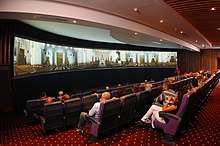Center for Documentation of Cultural and Natural Heritage
The Center for Documentation of Cultural and Natural Heritage (CULTNAT) of the Cultural Outreach Sector of the Bibliotheca Alexandrina plays an important and unique role in documenting Egypt's cultural heritage in its tangible and intangible aspects, besides Egypt's natural heritage from protectorates and wildlife. The Center has contributed, for nearly two decades, to documenting and disseminating information related to heritage through the implementation of many projects for digital documentation of Egyptian heritage using the latest information technology technologies in cooperation with specialized local and international bodies and the center is keen to increase awareness of cultural and natural heritage and the Egyptian identity by benefiting from various media channels. CULTNAT also builds the capacities of workers in the field of documenting and preserving civilizational and natural heritage.
 CULTNAT premises | |
| Motto | "The Art of Documenting Heritage" |
|---|---|
| Established | October 1, 2000 |
| Staff | 120 |
| Address | Smart Village, Kilo 28, Cairo-Alex Desert Road |
| Location | Giza, Egypt |
| Website | http://www.cultnat.org |

.[1] CULTNAT is involved in a large number of domestic[2] and international programs. It was established in 2000, and is located in Smart Village.[3][4]
In partnership with the Center, IBM created a multi-language educational site featuring Egypt's rich history, called Eternal Egypt.[5] The Center collects, organizes, and compiles information into databases[6] and produces educational films.
The Center received the first prize for innovative use of technology in the 2004 Stockholm Challenge for its work called The Archaeological Map of Egypt.[7]
The Center received honorable mention for a work called The Temple of Dendera.[8] CultNat created an educational website called The Global Egyptian Museum that can be used by teachers in their classrooms.[9]
In 2006, the Center digitized the photographic work of Lehnert & Landrock, photographers who had documented Egypt in the early 20th century.[10]
In 2011, the Center created a photographic exhibition called PME, and displayed Egypt's heritage with photos and mementos.[10]
In 2015, the Center published the memoirs of Egyptologist Selim Hassan.[11]
A branch of the center called Hathor House was slated to open in Serabit el-Khadim in South Sinai in 2013.[12]
References
- Ahmed Sedky (1 April 2009). Living with Heritage in Cairo: Area Conservation in the Arab-Islamic City. American University in Cairo Press. pp. 180–. ISBN 978-1-936190-63-8.
- Montasser, Farah (21 July 2011). "Folk: El-Sennary House Festival". Ahram Online. Retrieved 17 October 2018.
- "Contact Us". CultNat. CultNat. Archived from the original on 18 October 2018. Retrieved 17 October 2018.
- United Nations. Department of Economic and Social Affairs (2010). Compendium of Innovative E-government Practices. UN. ISBN 978-92-1-123184-7.
- "Eternal Egypt Portal". Eternal Egypt. Retrieved 17 October 2018.
- "About". CultNat. CultNat. Archived from the original on 18 October 2018. Retrieved 17 October 2018.
- "Egypt has taken first prize in the Stockholm Challenge Award 2004" (PDF). UNPAN. United Nations. Retrieved 19 October 2018.
- "ICON Int'l Committee for Audiovisual, New technologies and social media 2010 Winners". AVICOM.
- "The Global Egyptian Museum". Global Egyptian Museum. CultNat.
- Noshokaty, Amira (10 January 2011). "Folk Art: Na'ima al-Misriyya in focus". Ahram Online. Retrieved 18 October 2018.
- Noshokaty, Amira (17 September 2015). "Memoires of an Egyptology guru". Ahram Online. Retrieved 17 October 2018.
- El-Aref, Nevine (11 April 2013). "Hathor House for South Sinai heritage to open soon". Ahram Online. Retrieved 18 October 2018.